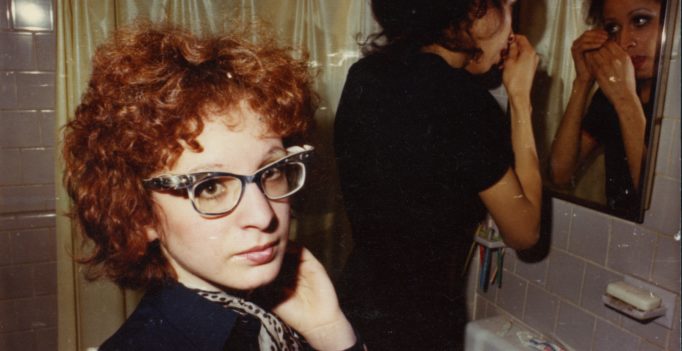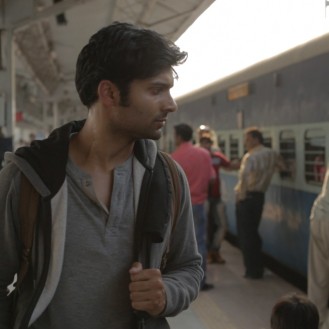Academy Award-winning director Laura Poitras (Citizenfour; My Country, My Country) doesn’t hold back in her latest documentary, a devastating portrait of fiery artist and activist Nan Goldin. Words like “heartbreaking” and “inspiring” are insufficient to describe this powerful story of community, activism, and survival.
All the Beauty and the Bloodshed begins during a protest at the Metropolitan Museum of Art in New York. There is a close-up shot of Nan chanting “temple of money”, accusing the museum (and, by extension, the most elite rungs of the international art establishment) of corruption. The camera is held by a member of the protest, bringing the viewer immediately into the center of the movement. We are urged to share the perspective of the demonstrators, who stage a “die-in” on the floor of the gallery among a litter of shocking orange prescription bottles.
It is Nan and the protesters against the rich and powerful. David versus Goliath.
Nan Goldin is perhaps best known for her raw and intimate photographs of New York’s gay and lesbian scene during the 1980s and 1990s. Her images of queer life, friendship, and grief placed her at odds with the more conservative circles of the mainstream arts establishment. But she still earned a name for herself and made her way into the permanent collections of big-name galleries like the Getty Museum, Art Institute of Chicago, Guggenheim Museum, and Metropolitan Museum of Art.
Poitras’ documentary features a selection of images from Goldin’s most famous exhibitions and works, as well as family photographs and self-portraits. In voice-over interviews, Nan describes her life and career. She also talks candidly about her experiences with addiction. When she is prescribed OxyContin after serious injury, Nan takes her medication as prescribed — unaware that she will soon slip into the thralls of a serious opioid addiction. After she seeks treatment, Nan learns that Purdue, the company responsible for producing OxyContin, knew that its product was addictive and dangerous but aggressively marketed it to the American public and doctors anyway.
Together with other artists, activists, and people with lived experience of opioid addiction, Nan founds Prescription Addiction Intervention Now (PAIN). Using direct action, the organization seeks to bring the Sackler family to justice for their role in creating the opioid crises.
On its own, Nan’s fight against the Sackler family is a worthy documentary subject. What makes All the Beauty and the Bloodshed such an astounding and important film is that it isn’t just about PAIN or the opioid crisis. It is a portrait of Nan Goldin as a queer artist and activist. A testament to the power of the queer female gaze, and a reminder of the strength of community.
“My relationships that have mattered most to me my whole life are my friends,” Nan declares. Simultaneously, she articulates one of the most revolutionary parts of many queer people’s lives: our understanding of relationships and support networks beyond monogamous romantic partnerships and nuclear families. Many of us find freedom in rewriting the script and finding ways to care for each other.
Nan recalls her childhood and her older sister who committed suicide when Nan was a teenager. She describes her parents, who were determined to hide the truth about her sister’s death. We see that Nan’s family history is wrapped in layers of silence. The film, and Nan’s unflinching retelling of her own story, cuts through to the core of the issue: shame. Mental health. Trauma. Sexual desire. Pleasure. These are things to be shut away and hidden. Propriety leaves no room for healing.
Like many LGBTQ+ people, Nan leaves her family of origin and finds a chosen family. First, at a hippie school where she takes up photography and, later, among the artists, drag queens, and punks of 1970’s Times Square.
All the Beauty and the Bloodshed covers a lot of ground, but the many different facets of Nan’s life and work come together to form a complex and thought-provoking whole that is more than a grim wake-up call about the opioid crisis or a celebration of an important artist’s multi-decade career.
The story is an example of the power of art and artists to inspire real change. Nan’s art, life, and activism show the overlap between the personal and the political. Nan’s individual struggle with addiction and abuse becomes part of a larger, collective struggle against corporate greed and patriarchal violence.
All the Beauty and the Bloodshed is Poitras at the top of her game. It is a must-see reminder that the social issues plaguing marginalized communities today — like homophobia, violence toward women, colonial and racist violence — are products of the same oppressive systems that protect those with wealth and power. And that grassroots, collective activism can work.
**********
Do You Tweet? Follow These Tweeple:
Shannon Page: @ShannonEvePage




Be the first to comment